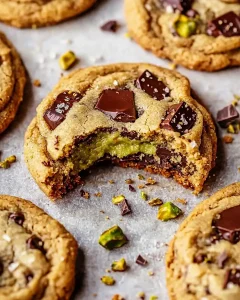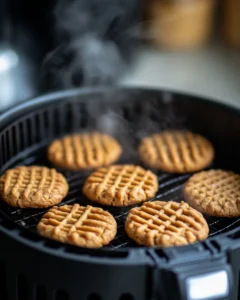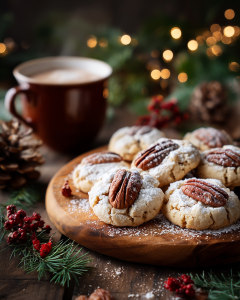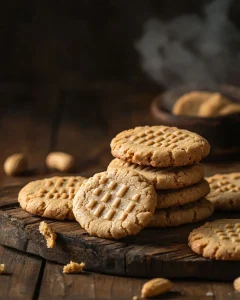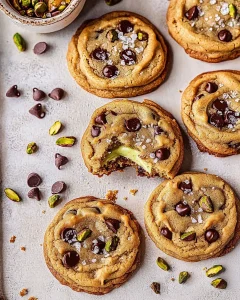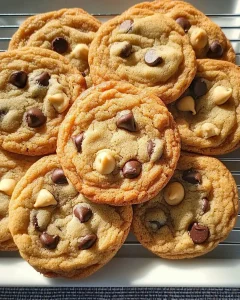The Ultimate Guide to Easy Pecan Cookies
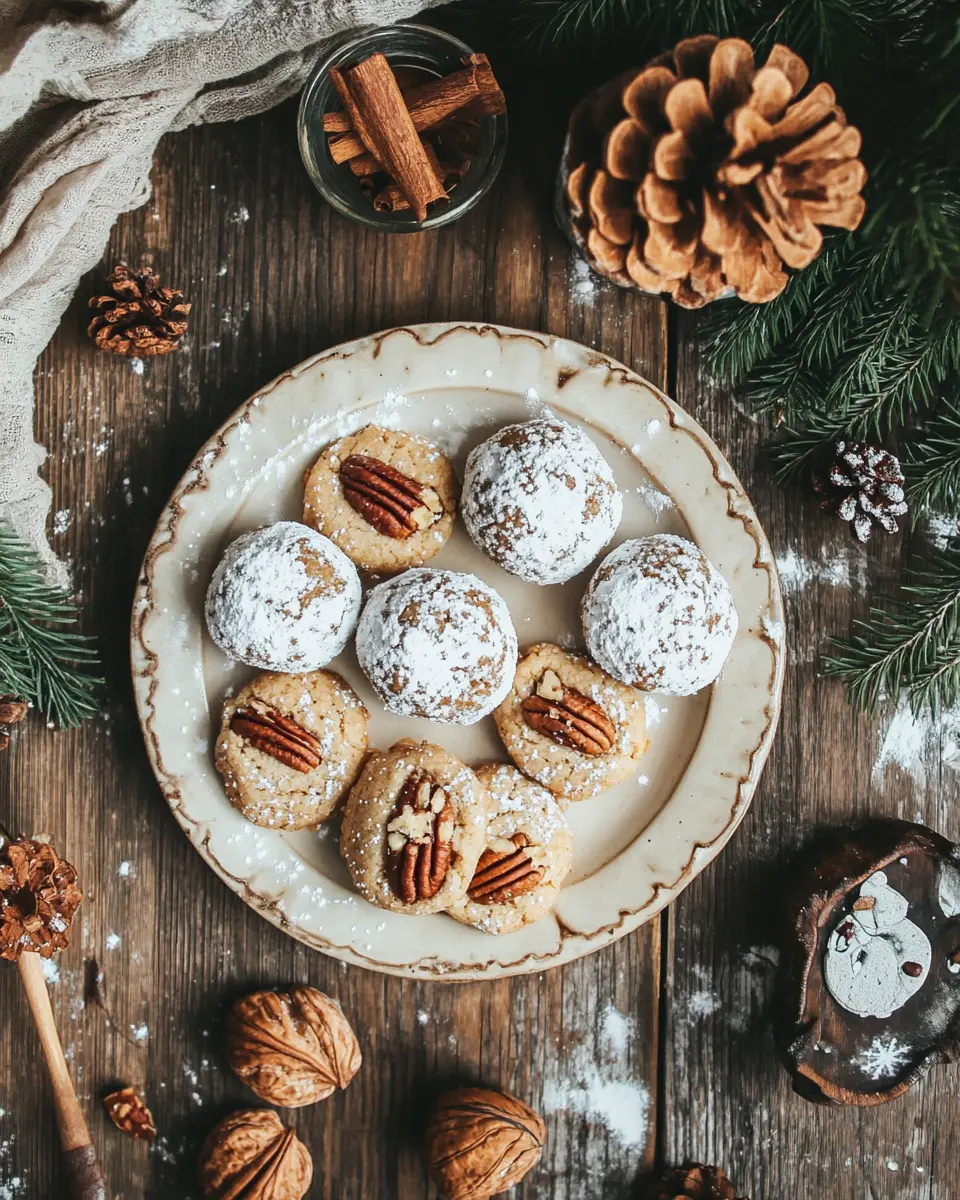
Easy Pecan Cookies represent one of America’s most beloved baking traditions, combining the rich, buttery flavor of native pecans with time-tested cookie-making techniques. Whether you’re a beginner baker looking for your first success or an experienced home cook seeking to perfect classic recipes, this comprehensive guide covers everything you need to know about creating exceptional pecan cookies.
According to the National Pecan Shellers Association, Americans consume over 300 million pounds of pecans annually, with a significant portion going into holiday baking. This guide will walk you through six distinct approaches to pecan cookie mastery, each designed to help you create memorable treats for any occasion.
Table of Contents
Easy Pecan Nut Ball Cookies – The Perfect Starting Point
Pecan nut ball cookies, also known as Mexican wedding cookies or Russian tea cakes, offer the ideal introduction to pecan cookie baking. These bite-sized treats require minimal ingredients and forgive common beginner mistakes while delivering professional-looking results.
Why Start with Nut Ball Cookies?
The beauty of pecan nut ball cookies lies in their simplicity. Unlike rolled cookies that require precise thickness or drop cookies that need perfect spacing, nut balls are formed by hand, giving you complete control over size and shape.
Essential Techniques for Success
The key to exceptional pecan nut balls starts with proper pecan preparation. Toasting your pecans for 8-10 minutes at 350°F intensifies their natural oils and creates the nutty depth that distinguishes homemade cookies from store-bought alternatives. This crucial step, often overlooked in simplified recipes, transforms ordinary ingredients into something extraordinary.
Temperature control proves equally important. Room temperature butter creates the ideal texture – soft enough to incorporate easily but firm enough to hold the cookie’s shape. Professional bakers recommend the “finger test”: properly tempered butter should yield to gentle pressure without leaving an indentation.
The Secret to Professional Results
The difference between good and exceptional pecan nut balls lies in the double dusting technique. After the initial baking, cookies receive their first coating of powdered sugar while still warm, allowing the sugar to partially melt and adhere. A second dusting after cooling creates the signature snowy appearance that makes these cookies irresistible.
Ready to try your hand at these beginner-friendly treats? Our detailed easy pecan nut ball cookies recipe includes step-by-step photos and troubleshooting tips to ensure your first batch turns out perfectly.
Festive Christmas Pecan Cookies – Holiday Baking Excellence
Christmas pecan cookies hold a special place in American holiday traditions, with recipes passed down through generations and adapted to regional preferences. These festive treats combine the comfort of familiar flavors with the joy of seasonal baking, creating memories that last long after the last cookie disappears from the plate.
Historical Significance and Regional Variations
Pecan cookies became synonymous with Christmas baking in the American South during the late 1800s, when pecan trees were abundant and sugar became more readily available.
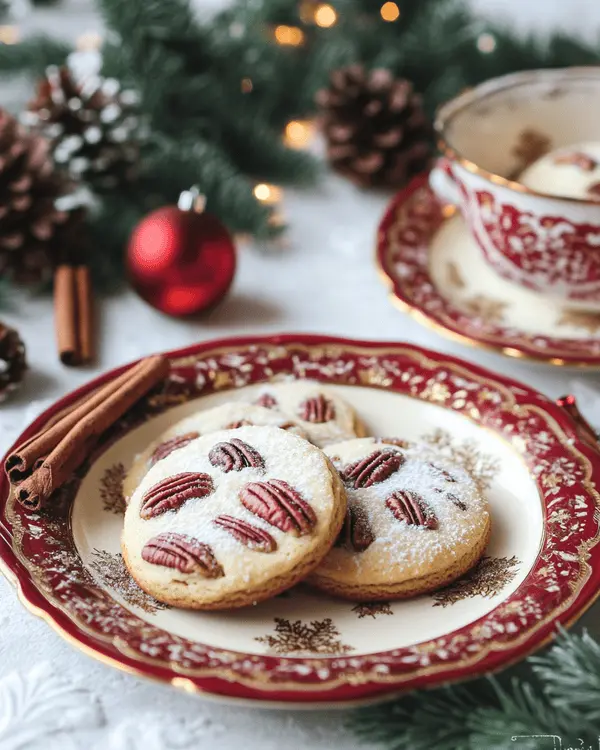
Elevating Your Holiday Cookies
The secret to memorable Christmas pecan cookies lies in balancing traditional techniques with thoughtful enhancements. Brown butter, created by cooking butter until it reaches a golden amber color, adds a nutty complexity that complements pecans naturally. This French technique, called “beurre noisette,” transforms simple ingredients into something sublime.
Spice selection also defines exceptional holiday cookies. While vanilla remains essential, a carefully balanced blend of cinnamon, nutmeg, and a pinch of cardamom creates the warm, comforting flavors associated with Christmas baking. The key is restraint – spices should enhance, not overpower, the delicate pecan flavor.
Presentation and Gift-Giving
Christmas pecan cookies excel as homemade gifts when properly packaged and presented. Layering cookies between parchment paper in decorative tins preserves their texture while creating an appealing presentation. For optimal freshness, cookies should be completely cooled before packaging and can maintain quality for up to two weeks when stored properly.
Make-Ahead Strategies
Smart holiday bakers know that cookie dough can be prepared weeks in advance and frozen until needed. Properly wrapped pecan cookie dough maintains quality for up to three months in the freezer, allowing you to enjoy fresh-baked cookies throughout the holiday season without the stress of last-minute preparation.
Transform your holiday baking with our comprehensive festive pecan cookies for Christmas baking guide, featuring traditional recipes and modern twists that will become new family favorites.
Powdered Sugar Pecan Cookies – Sweet Perfection
Powdered sugar pecan cookies represent the pinnacle of elegant simplicity in cookie baking. The delicate sweetness of confectioner’s sugar creates a melt-in-your-mouth texture that perfectly complements the rich, nutty flavor of pecans, resulting in cookies that feel both indulgent and refined.
Understanding Powdered Sugar’s Role
Powdered sugar does more than add sweetness to pecan cookies – it fundamentally alters their texture and structure. Unlike granulated sugar, which creates spread and chewiness, powdered sugar produces tender, delicate cookies with a fine crumb. The cornstarch typically added to commercial powdered sugar acts as a natural tenderizer, contributing to the cookies’ signature soft texture.
The Art of Proper Dusting
The iconic appearance of powdered sugar pecan cookies comes from the final dusting technique, but timing and method matter significantly. Dusting too early causes the sugar to dissolve completely, while dusting too late prevents proper adherence. Professional bakers dust cookies twice: once while still slightly warm to create an initial coating that partially melts and adheres, then again after complete cooling for the final snowy appearance.
Quality powdered sugar makes a noticeable difference in both flavor and appearance. Premium brands contain less cornstarch and create a purer, sweeter flavor profile. Some bakers prefer to make their own by processing granulated sugar in a food processor until powder-fine, though this requires careful attention to avoid overprocessing.
Balancing Sweetness and Flavor
The challenge in powdered sugar pecan cookies lies in achieving proper balance. Too much powdered sugar overwhelms the delicate pecan flavor, while too little fails to create the characteristic tender texture. Master bakers often reduce other sweeteners in the dough when using powdered sugar coating, allowing the pecans to shine while maintaining the desired sweetness level.
Storage and Serving Considerations
Powdered sugar coating requires special storage considerations. Humidity can cause the sugar to dissolve or become sticky, so these cookies perform best in dry environments. For optimal presentation, many bakers give cookies a final light dusting just before serving, ensuring the pristine white appearance that makes these cookies so visually appealing.
Discover the secrets to creating ethereally light and sweet treats with our detailed guide to the best cookies with pecans and powdered sugar, including professional techniques for perfect results every time.
Beginner’s Guide to Pecan Balls – Foolproof Techniques
Learning to make pecan balls represents an ideal entry point into serious cookie baking. These forgiving cookies teach fundamental techniques while delivering impressive results that build confidence for more challenging recipes. Understanding the science behind their simplicity helps beginners develop skills that transfer to all types of cookie making.
Why Pecan Balls Work So Well for Beginners
Pecan balls succeed where other cookies might fail because they rely on technique rather than precision. Unlike sugar cookies that require exact measurements and perfect rolling, or chocolate chip cookies that depend on precise timing, pecan balls forgive minor measurement variations and timing differences while still producing delicious results.
Essential Equipment and Ingredients
Successful pecan balls require minimal specialized equipment, making them accessible to bakers with basic kitchens. A standard mixer, measuring cups, and cookie sheets are sufficient. The key lies in understanding how each tool contributes to the final result.
A food processor, while not essential, significantly improves pecan incorporation. Pulsing pecans to the proper size – fine enough to distribute evenly but coarse enough to provide texture – creates the ideal foundation. Hand-chopped pecans work perfectly well but require more attention to achieving uniform size.
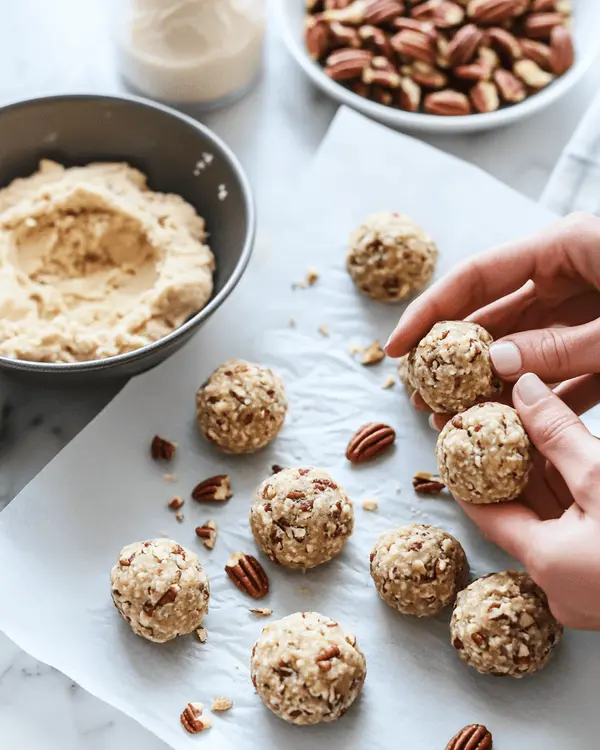
Mastering the Fundamentals
Temperature control represents the most critical skill in pecan ball making. Butter that’s too cold won’t cream properly, while overly warm butter creates greasy dough that spreads excessively during baking. The ideal butter yields slightly to pressure but maintains its shape – what professionals call “pliable but cool.”
Mixing technique directly impacts texture. Overworking flour develops gluten, creating tough cookies, while undermixing leaves flour pockets that cause uneven texture. The goal is just enough mixing to eliminate dry flour without activating gluten development.
Recognizing Success Indicators
Beginning bakers often struggle with recognizing properly baked cookies. Pecan balls are done when they’re set but not browned – they should feel firm to gentle touch but not hard. The bottoms may show light golden color, but the tops should remain pale. This visual cue becomes intuitive with practice.
Building Confidence Through Success
The reliability of pecan balls builds baking confidence like no other cookie. Their consistent results help beginners understand what “done” looks and feels like, establishing benchmarks for future baking adventures. Success with pecan balls often inspires bakers to attempt more challenging recipes with greater confidence.
Start your cookie baking journey with confidence using our comprehensive easy pecan balls recipe for beginners, designed to guarantee success while teaching essential techniques.
Classic Pecan Cookies – Mastering Traditional Methods
Classic pecan cookies represent the gold standard of American cookie baking, embodying decades of refinement and tradition. These time-tested recipes have survived because they work – consistently producing cookies that satisfy both nostalgic expectations and modern palates. Understanding the principles behind classic recipes provides the foundation for all pecan cookie variations.
The Evolution of Classic Recipes
Traditional pecan cookie recipes emerged during the early 20th century when American home baking reached new levels of sophistication. The Smithsonian’s National Museum of American History documents how these recipes evolved from simple nut cookies into the refined treats we know today, influenced by European techniques and American ingredient preferences.
Classic recipes typically feature a 3:2:1 ratio – three parts flour, two parts butter, one part sugar – with pecans and flavorings added to taste. This foundational ratio creates the ideal balance of structure, richness, and sweetness that defines superior pecan cookies. Understanding this ratio allows bakers to scale recipes confidently and make informed adjustments.
Traditional Techniques That Matter
The creaming method, fundamental to classic pecan cookies, requires proper understanding to execute successfully. Cream butter and sugar until light and fluffy – this isn’t just about mixing ingredients but about incorporating air that creates tender texture. Properly creamed butter increases in volume by roughly one-third and becomes noticeably lighter in color.
Flour incorporation technique separates good from exceptional classic cookies. Professional bakers add flour in three additions, mixing just until incorporated after each addition. This prevents overworking while ensuring even distribution. The final dough should be cohesive but not sticky, with visible pecan pieces evenly distributed throughout.
The Importance of Quality Ingredients
Classic recipes rely on ingredient quality more than complex techniques. Premium butter with higher fat content creates richer flavor and better texture. Fresh pecans, preferably from the current harvest, provide the nutty intensity that defines these cookies. Many professional bakers recommend storing pecans in the freezer to maintain freshness and prevent rancidity.
Pure vanilla extract, not imitation, contributes the subtle flavor complexity that distinguishes homemade from commercial cookies. The alcohol in pure vanilla carries flavors that artificial vanilla cannot replicate, creating a more rounded, satisfying taste profile.
Timing and Temperature Precision
Classic pecan cookies require attention to timing and temperature details that separate adequate from exceptional results. Oven temperature accuracy matters significantly – variations of even 25°F can mean the difference between perfectly baked cookies and disappointing results. Investment in an oven thermometer ensures consistent results.
Cooling technique affects final texture. Cookies should rest on the baking sheet for 2-3 minutes before transferring to cooling racks. This brief rest allows the structure to set while preventing breaking, while prompt removal prevents overbaking from residual heat.
Master the fundamentals of traditional baking with our detailed guide on how to make classic pecan cookies at home, featuring time-tested techniques and professional insights.
The Perfect Pecan Cookie Recipe – Professional Results
Achieving pecan cookie perfection requires understanding the subtle interactions between ingredients, techniques, and timing that separate good cookies from extraordinary ones. This final section synthesizes professional insights and advanced techniques to help you create pecan cookies that rival those from the finest bakeries.
Defining Perfection in Pecan Cookies
Perfect pecan cookies balance multiple elements: tender texture without crumbliness, rich pecan flavor without greasiness, appropriate sweetness without cloying, and appealing appearance that matches the exceptional taste.
Professional bakers evaluate pecan cookies on five criteria: texture (tender but not fragile), flavor balance (nutty richness with subtle sweetness), appearance (even color and consistent size), aroma (fresh, buttery, and nutty), and mouthfeel (satisfying but not heavy). Meeting all five criteria consistently defines true pecan cookie mastery.
Advanced Ingredient Selection and Preparation
Perfect pecan cookies begin with exceptional ingredients treated with professional care. Premium European-style butter with 82-84% fat content creates superior texture and flavor compared to standard American butter. The higher fat content produces more tender cookies with richer taste.
Pecan selection requires attention to variety, freshness, and preparation. Mammoth pecans provide the most dramatic visual impact, while smaller varieties like Desirable offer more concentrated flavor. Toasting pecans until fragrant but not dark intensifies their natural oils and creates the deep, nutty flavor that defines exceptional cookies.
Professional bakers often enhance pecan flavor through compound techniques. Browning a portion of the butter creates nutty notes that complement the pecans, while a small amount of almond extract amplifies the overall nut flavor without being identifiable as a separate element.
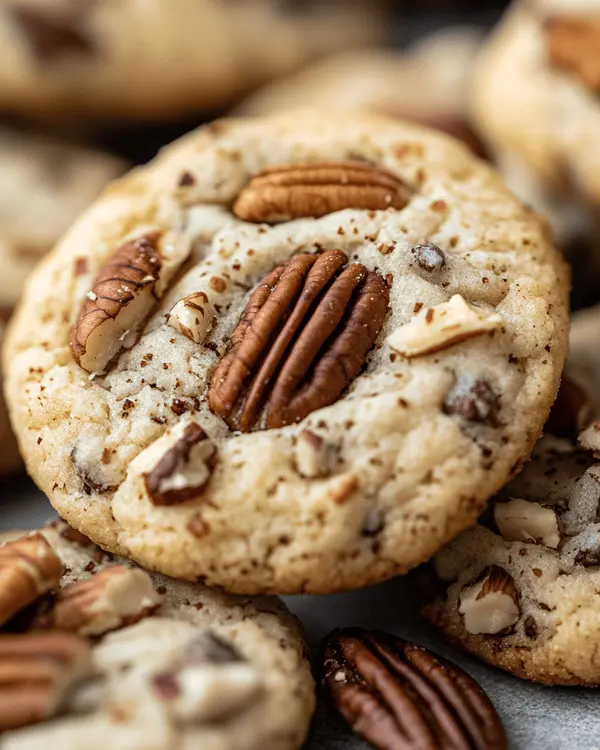
Precision Techniques for Consistent Excellence
Temperature control extends beyond basic room temperature ingredients to precise thermal management throughout the process. Professional kitchens maintain butter at exactly 65-68°F for optimal creaming. Flour temperature affects hydration, so many professionals bring flour to room temperature before use.
Mixing technique requires balancing thorough incorporation with minimal gluten development. Professional bakers often use the “reverse creaming” method, combining flour with cold butter pieces before adding liquids. This technique, popularized by pastry chef Rose Levy Beranbaum, produces incredibly tender cookies with fine crumb structure.
Quality Control and Consistency
Achieving consistent perfection requires systematic quality control. Professional bakers weigh ingredients rather than measuring by volume, ensuring identical results batch after batch. Cookie size uniformity comes from using portion scoops or scales to ensure each cookie contains identical amounts of dough.
Baking multiple sheets requires rotation techniques and timing adjustments to ensure even results. Professional ovens often have hot spots, so rotating sheets halfway through baking and adjusting positions ensures uniform browning and texture.
Professional Presentation Standards
Perfect pecan cookies require attention to presentation details that distinguish homemade from bakery quality. Consistent sizing, even browning, and attractive appearance contribute significantly to perception of quality. Professional bakers often reserve the most attractive cookies for display while using less perfect ones for sampling or casual serving.
Storage techniques affect both quality and presentation. Professional bakeries use specific containers and layering methods to maintain texture while preventing damage during storage and transport.
Elevate your baking to professional standards with our comprehensive guide to the perfect pecan cookies recipe, featuring advanced techniques and insider secrets from professional bakers.
Conclusion: Your Journey to Easy Pecan Cookies Mastery
Mastering pecan cookies represents more than learning recipes – it’s about understanding the fundamental principles that create consistently exceptional results. From the beginner-friendly pecan balls that build confidence to the advanced techniques that create bakery-quality perfection, each approach contributes to your overall baking expertise.
The beauty of pecan cookies lies in their versatility and forgiveness. Whether you’re creating simple treats for everyday enjoyment or sophisticated cookies for special occasions, the techniques and insights in this guide provide the foundation for success. Remember that baking skill develops through practice, and even imperfect cookies often taste delicious while teaching valuable lessons.
As you explore these different approaches to pecan cookie making, consider how each technique contributes to your broader understanding of baking. The temperature control learned in pecan balls applies to all cookie making. The ingredient balance principles from classic recipes inform countless other baking projects. The precision techniques from perfect cookies elevate everything you create in your kitchen.
Start with the approach that best matches your current skill level and interests, then gradually incorporate techniques from other sections as your confidence grows. Soon you’ll find yourself creating pecan cookies that not only satisfy your own high standards but also delight everyone fortunate enough to taste them.

